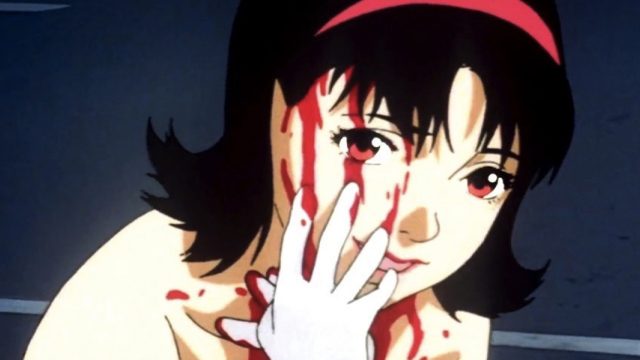Darren Aranofsky is clearly obsessed with Perfect Blue. He’s used the themes, plot, and style in multiple films by now, especially the brilliant Black Swan, and it’s hard not to see why. Few movies fully depict disassociative episodes so ruthlessly, forcing the audience to question what exactly is happening to pop star Mima. The best comparisons are Repulsion, The Shining: “something is happening, but you don’t know what it is.” Perfect Blue is a paranoid, flawed piece of work, and it demands patience.
The film follows Mima, a minor pop star turned actress shooting her first real role in a winkingly stupid serial killer drama. As she becomes a victim of a stalker and shoots an awful rape scene however, she starts to lose her grip, unsure of her actual identity. And then people involved with the show start getting murdered…
Director Satoshi Kon plays endlessly with key images and sequences: hard cuts to Mima waking in her bed after an episode. The fantasy Mima dancing her way back into pop idolatry. Fish that are dead then are…not? The second act blurs the lines of reality and falsity ruthlessly, dazzling the audience. The film only clues you in on what is actually occurring with 10 minutes left, and the reveal is oddly disappointing – I almost preferred to be immersed in hallucination compared to the truth. Visual motifs appear throughout of the color red, especially in blood from the powerful men Mima may or may not have killed in revenge for exploitation. Mirrors and doubling are a constant as well, showing the fracture of Mima’s perception.
The film was released in 1997, just as the Internet was beginning to explode as a commercial and critical force in the world. (In a very 1997 detail Mima has no idea how to use it.) The celebrity stalker had gained a serious footing. John Lennon was shot by a fanatic in 1980. In 1997, a bodybuilder became sexually obsessed with Steven Spielberg and is still in prison for his harassment and threats. John Hinckley wanted Jodie Foster to know of his great deed in shooting Ronald Reagan. As the celebrity became a greater and greater icon of cultural power and fetishization, emerging as the modern aristocrat, the fascination and fixation easily became violent.
Blue shows the packaging of fame and everything that comes with it: being controlled, manipulated, loved, and despised, all at once. The identity of the celebrity is endlessly commodified and picked over. Mima’s split in identity is between the two roles she’s allowed to have as a female star: Hot Sexy Actress and Fun Pop Idol. The ending suggests that the love of stars is inherently violent, especially for women – eventually, the fan will need to destroy them. Curiously in the film, that catharsis is what allows Mima to solidify her new self, at least up to a point. (In the Japanese original film, a final line reading by a key voice actress suggests some slight ambiguity. This isn’t in the English dub unfortunately.) The presence of the Mima’s Room website in particular is incredibly prescient: celebrities have become more human to fans with social media, with blogs and the ability of millions to read their opinions and individual voices. Mima’s Room is a twisted reversal of this notion, as the site accurately presents Mima’s real feelings…while not being written at all by Mima, causing her identity to feel even more fractured as she reads the posts.
Like Repulsion and Swan, Kon uses the trope of the Mad Woman but in a feminist context. (Though he still blurs the line between exploitation and critique a la DePalma, the biggest influence here beyond Hitchcock or Polanski.) Mima has no agency until the very end – at one point she cowers in the same room as her agent and handler argue over her own career choices, and a male, leering photographer gets her to strip for a photo shoot. Mima’s insanity and fight for survival are eventually what gives her a real grasp of Self. Still, part of the problem with the movie is that as a result Mima is a fairly bland character, but it doesn’t know how to make that compelling. The script doesn’t know how to translate its own weird and clever qualities into a solid protagonist.
Ultimately Blue only falters in its final minutes – as a friend of mine suggested, the cheerful ending doesn’t quite work after what we see of the daily horror of fame. The stalkers are vanquished sure, but there are going to be more, and there are always more people ready to exploit Mima’s body, to demand more of her than she should be willing to give. A more permanently ambivalent final scene would’ve had a bigger impact without the endorphin rush of a happy pop song in the credits. But it’s predicting of where culture would go in the next twenty years – from Twitter to Instagram as sources of worship and pain, how female performers are relentlessly prodded and controlled – and the often stunning psychological terror of Kon’s style has given it lasting value and power.

